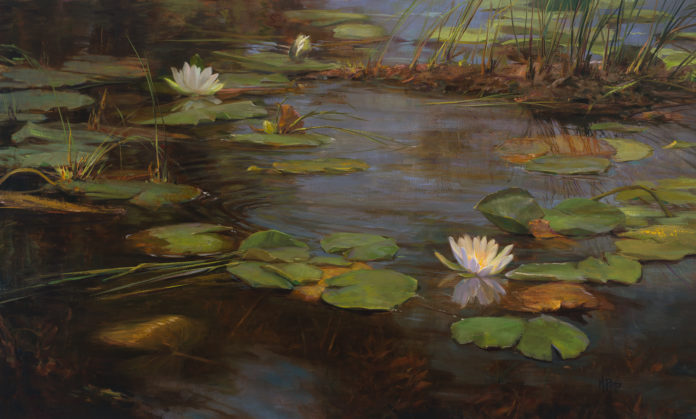Nineteenth-century French composer Claude Debussy (1862-1918) often invited his audiences to “see” art and abstract visual elements in his music. Collaborating with him across time is master painter Mary Pettis, who will soon mount a breathtaking solo exhibition that celebrates the music in art and the art in music.
The Minnesota Orchestra will perform five brilliant movements from Claude Debussy’s Images for Orchestra in Minneapolis on June 8, 9, and 10. Joining the performances at the newly renovated Orchestra Hall will be “Beyond the Surface,” a solo exhibition by expressive realist Mary Pettis featuring paintings created specifically for the concert.
Twenty paintings by Pettis will be on view, five of which pair directly with the five performed movements. To be sure, the exhibition is not a series of literal illustrations of Debussy’s Images for Orchestra, but rather a celebration of the connection between the languages of paint and Debussy’s compositions. “Pettis emphasizes the musicality of visual arts as a vehicle of deliberate expression,” according to the press materials. “And like Debussy’s compositions, this exhibition is designed to satisfy the viewer on both an intuitive and a technical level.”

The exhibition equally highlights expressive realism, a contemporary movement that fuses the purest elements of art (such as color, texture, and form) with familiar, timeless subjects. “Expressive realism employs, rather than shuns, the artistic language uncovered by the modern art movement. The result is an intensely fulfilling visual experience, both for the art novice and for those who are drawn to spend the time to look beyond the surface,” the announcement continues. “As Debussy invited his audience to look for images in the music, Pettis invites the viewer to see music in the images. [Debussy] often used nostalgic images and songs as source material for his tradition-breaking style. Mary uses a similar approach: she translates the visual world into evocative sensory experiences.”
The show’s signature painting, “The Cycle of Lilies,” is a representative example of this intriguing concept and is paired with the second movement of Debussy’s Images for Orchestra, titled Ibéria: Les Parfums de la Nuit. Viewers find themselves among a peaceful, tightly cropped grouping of waterlilies and cattails. Two brilliant flowers are in full bloom, adding highlights of white and giving the eye a resting point from the soft arrangement of green pads that sweeps across the linen. Cool blue and purple hues indicate the surface of the water and illuminate soft ripples that approach the viewer. Deep yellows, oranges, and browns compose elements below the surface, providing a strong foundation and balance to the palette.
“Like the melodic woodwinds echoing the oscillating motion of the accompaniment, the gentle movement of the water’s surface affects all of the plant life residing within it,” a description reads. “The weeds below reveal glimpses of hidden, nourishing depths felt in the ambient bass. The floating opalescent flowers catch the eye against the strong dark reflections of the unseen trees, in the same way that the light reedy oboe and the breathy flute bring their melody to the forefront of the orchestra. The lily pads lazily dip in and out of the water in syncopation, mirroring the flowing movement within the strings. And much like Les Parfums de la Nuit, the longer you let the work wash over you, the more enriched and immersed you become.”
That, folks, is 1/20th of the show. I will certainly be there, will you?
To learn more, visit Mary Pettis.
This article was featured in Fine Art Today, a weekly e-newsletter from Fine Art Connoisseur magazine. To start receiving Fine Art Today for free, click here.









[…] Club, the exhibition consists of a handful of Pettis’ recent works, including several from her recent project with the Minnesota Orchestra in which the artist created a series of special paintings in connection with the performance of […]